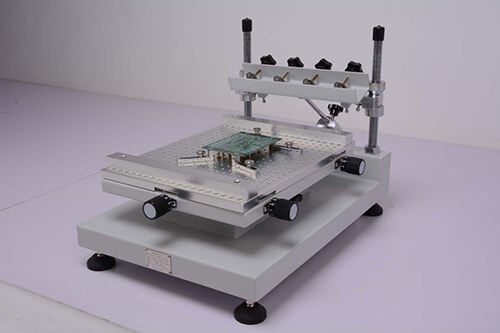Understanding Core SMT Equipment and Electronics Production Machinery
Matching Machine Capabilities to Product Type and Complexity
When it comes to manufacturing modern electronics, the production equipment really needs to match what the final product actually requires. For something simple like an LED board, even basic pick and place machines can get the job done, typically placing around 8,000 components each hour. But when we're talking about those fancy IoT modules, things get much more complicated. These need specialized micro nozzle systems that can handle those tiny 0201 metric chips with placement accuracy above 98%. And don't even get me started on HDI boards. They absolutely require solder paste inspection systems that can spot voids as small as 15 microns. Without this level of detail checking, there's always a risk of those annoying field failures showing up later down the road after products have already been shipped out.
Defining Production Volume, Mix, and Future Scalability Needs
A smartphone manufacturer producing 500,000 units monthly needs dual-lane SMT lines with 45,000 CPH throughput, whereas a medical device maker managing 50 variants requires machines enabling <15-minute changeovers. Leading automotive suppliers now design modular lines with conveyor extensions and hot-swappable feeder racks to accommodate projected 300% increases in EV controller demand.
The Shift Toward High-Speed Surface Mount Technology in Modern PCB Assembly
Industry 4.0 adoption has accelerated surface mount technology (SMT) speeds by 40% since 2021, with 01005 component placement now achievable at 0.025mm precision. Nitrogen-assisted reflow ovens reduce void rates to <2%, significantly improving reliability compared to traditional air systems that average 5–8%, particularly critical for automotive-grade assemblies meeting IPC-610 Class 3 standards.
Optimizing SMT Line Configuration for Mid-Volume Manufacturers
A mid-volume aerospace contractor redesigned their workflow using hybrid SMT lines combining a high-speed chip shooter (32,000 CPH) with flexible fine-pitch placers. This configuration reduced capital costs by 25% while maintaining a 99.4% first-pass yield across 87 product variants—essential for defense contracts requiring rapid prototype-to-production transitions.
Emerging Trend: Integration of Smart Sensors in Pick and Place Machines
Vision-guided robotic arms now use multispectral imaging to detect tombstoning risks during component pickup, correcting placement angles in under 2ms. Pilot implementations show a 60% reduction in post-reflow corrections, especially beneficial for moisture-sensitive components like QFN packages in humid environments.
Evaluating Key Electronics Production Machinery: Pick and Place, Reflow, and Conveyor Systems
Critical Parameters for High-UPH Pick and Place Machines
Today's pick and place machines manage both speed and precision when working with tiny components. Speed is typically measured in components per hour (CPH), while accuracy reaches down to about 0.025 mm either way. These machines can handle really small parts thanks to their high feeder capacity, usually around 80 slots or more, plus they have those handy automated nozzle changers that keep production going without stopping for complex printed circuit boards. The vision systems are pretty impressive too, featuring those 15 megapixel cameras that check where each component goes as it happens. This real time verification cuts down on mistakes significantly, roughly cutting error rates in half compared to older models from just a few years back.
Impact of Component Miniaturization on Placement Accuracy and Cycle Time
The rise of 01005 (0.4 à0.2 mm) and micro-BGA packages necessitates laser-aligned placement heads and 6Ï process capability. These smaller components require 32% slower cycle times to maintain ñ25 õm accuracy, though dual-lane conveyors help mitigate throughput loss without sacrificing precision.
Reflow Soldering Machines: Thermal Precision and Profile Optimization
Advanced 12-zone reflow ovens achieve thermal uniformity within ñ1.5ðC across PCB panels, essential for lead-free SAC305 alloys. Closed-loop systems dynamically adjust conveyor speed and zone temperatures based on real-time analytics, reducing thermal-related defects by 63% in high-density assemblies.
Synchronizing Conveyor Systems for Minimal Downtime
Smart conveyor modules feature dynamic width adjustment (150â600 mm range) and 0.5-second board spacing, ensuring seamless handoffs between stencil printers and AOI stations. Integrated buffer zones with 50-board capacity prevent line stoppages during feeder reloads, supporting 94% Overall Equipment Effectiveness (OEE) in mixed-volume production.
Integrating Automation and Industry 4.0 for Efficient SMT Line Operations
Modern electronics production machinery achieves peak efficiency through Industry 4.0 integration, where smart sensors and machine learning algorithms transform traditional PCB assembly lines into adaptive manufacturing ecosystems.
Real-Time Monitoring of Cycle Time and Line Change Frequency
IoT-enabled pick-and-place machines track placement rates at 50ms intervals, enabling predictive adjustments that reduce line stoppages by 38% in mixed-volume environments. According to a 2023 Industry 4.0 analysis, plants using real-time monitoring achieve 22% faster product changeovers while maintaining placement accuracy under 35ϼmâcritical for managing 15+ product variants daily.
Building Scalable, Modular Electronics Production Machinery Lines
Modular SMT configurations allow incremental upgrades such as 01005 component handling or dual-lane conveyors. Industry leaders leverage digital twins to simulate line expansions before physical deployment, reducing integration errors by 65% in documented case studies.
Speed vs. Flexibility: Balancing Needs in High-Mix, Low-Volume Manufacturing
High-speed machines delivering 72,000 CPH now incorporate quick-change tooling that reduces nozzle array swaps to 45 seconds. This enables single lines to alternate between rigid-flex boards and standard FR4 PCBs while maintaining <0.3% misplacement rates across small batches of 50â500 units.
Data-Driven Optimization Using Closed-Loop Feedback Systems
Advanced SMT lines use SPI data to automatically adjust stencil wipe frequency and reflow oven ramp rates. One automotive supplier reduced thermal profile deviations by 41% using this closed-loop method while cutting energy consumption per board by 18%, helping meet stringent IPC-610 Class 3 requirements.
Ensuring Quality Control and Reliability in Automated PCB Production
Integrating AOI and X-Ray Inspection with SMT Equipment
Today's PCB assembly operations rely heavily on automated optical inspection (AOI) alongside X-ray technology to spot those tiny issues that can ruin boards. These systems catch problems like components that are out of place, not enough solder paste applied, or hidden air pockets inside the joints. When manufacturers combine AOI with 3D X-ray imaging, they typically see around a two thirds reduction in defects slipping through compared to what humans could find manually. This makes sure surface mount devices actually live up to those strict IPC Class 3 requirements needed for critical industries like aerospace where reliability matters most, or medical equipment that simply cannot fail when lives are at stake.
Reducing Rework Rates Through Automated Process Control
Automated process control minimizes human intervention in soldering and placement, directly lowering rework. Closed-loop feedback adjusts parameters like stencil pressure and nozzle speed in real time, maintaining consistency across batches. Manufacturers report 40â60% fewer manual corrections after implementation, significantly improving throughput in high-mix settings.
78% of Solder Defects Linked to Inconsistent Thermal Profiles (IPC Study 2024)
Recent findings from the IPC highlight that thermal management is pivotal to solder joint integrity. Variations exceeding ñ5ðC in reflow oven zones are responsible for most bridging and cold solder issues, especially with fine-pitch components below 0.4mm pitch.
Maintaining Solder Joint Reliability Through Precision Temperature Control
Advanced reflow systems utilize multi-zone profiling and nitrogen inerting to maintain ñ1ðC temperature stability. This precision prevents irregular intermetallic compound (IMC) formation that compromises mechanical strength. Controlled heating ramps also minimize thermal shock on sensitive components like MLCCs, enhancing product longevity in demanding environments.
Assessing Total Cost of Ownership and Supplier Support for Electronics Production Machinery
Beyond Purchase Price: Lifecycle Costs and Energy Efficiency
Initial equipment costs represent only 30â40% of total lifecycle expenditures. A comprehensive TCO analysis includes energy consumptionâhigh-speed pick-and-place machines consume 15â25% more power than standard modelsâas well as predictive maintenance and compliance with emissions regulations. For example, optimizing reflow oven thermal efficiency can save mid-volume manufacturers $18,000â$32,000 annually.
Evaluating Supplier Reputation and Supply Chain Reliability
Prioritize vendors with ISO 9001-certified quality systems and documented lead times under four weeks for critical spare parts. Manufacturers leveraging localized supply networks experience 37% faster incident response during shortages compared to fully outsourced operations. Avoid machinery dependent on proprietary single-source components, which increase lifecycle costs by 12â19% over modular alternatives.
Warranty, Spare Parts Availability, and Technical Compliance
The best SMT equipment typically comes with warranties covering around 5 to 7 years of thermal system performance. Most problems we see actually stem from things like conveyor belts not syncing properly or using old solder paste formulas that just don't work anymore. If maintaining IPC-610 Class 3 standards is important, then having trained factory techs nearby really matters. Getting nozzle replacements within 48 hours at most makes all the difference when production stops. Plants that keep spare parts on site tend to run smoother overall. Studies show these facilities enjoy about 22 percent better uptime compared to places stuck waiting for parts from across the ocean.
Frequently Asked Questions (FAQ)
What is SMT equipment?
SMT stands for Surface Mount Technology. SMT equipment refers to the machinery used in the PCB assembly process, including pick and place machines, reflow soldering machines, and conveyor systems.
Why is placement accuracy important in SMT?
Placement accuracy ensures that components are positioned correctly on PCBs, minimizing errors and enhancing product reliability.
What are the benefits of Industry 4.0 in electronics production?
Industry 4.0 integrates smart sensors and machine learning to optimize manufacturing processes, reduce errors, and improve production speeds and quality.
How can manufacturers reduce production costs?
Manufacturers can conduct a total cost of ownership analysis, optimize energy consumption, and leverage predictive maintenance to reduce production costs.
Why is quality control vital in PCB assembly?
Quality control is essential to ensure reliability and safety, particularly in industries like aerospace and medical equipment where product failure is not an option.
Table of Contents
-
Understanding Core SMT Equipment and Electronics Production Machinery
- Matching Machine Capabilities to Product Type and Complexity
- Defining Production Volume, Mix, and Future Scalability Needs
- The Shift Toward High-Speed Surface Mount Technology in Modern PCB Assembly
- Optimizing SMT Line Configuration for Mid-Volume Manufacturers
- Emerging Trend: Integration of Smart Sensors in Pick and Place Machines
- Evaluating Key Electronics Production Machinery: Pick and Place, Reflow, and Conveyor Systems
- Integrating Automation and Industry 4.0 for Efficient SMT Line Operations
- Ensuring Quality Control and Reliability in Automated PCB Production
- Assessing Total Cost of Ownership and Supplier Support for Electronics Production Machinery
- Frequently Asked Questions (FAQ)

